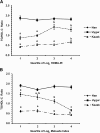Different lipid profiles, insulin sensitivity, and insulin resistance among Han, Uygur, and Kazak men with normal glucose tolerance in Xinjiang, China
- PMID: 30193578
- PMCID: PMC6128984
- DOI: 10.1186/s12944-018-0863-9
Different lipid profiles, insulin sensitivity, and insulin resistance among Han, Uygur, and Kazak men with normal glucose tolerance in Xinjiang, China
Abstract
Background: This study aimed to determine the differences in clinical parameters among Han, Uygur, and Kazak men with normal glucose tolerance.
Methods: Participants' data from the China National Diabetes and Metabolic Disorders Study pertaining to Han, Uygur, and Kazak men from the Xinjiang province were used (n = 930). Pearson's correlation was used to examine the relationship between HOMA-IR, Matsuda Index, and clinical characteristics.
Results: HOMA-IR of Han men was significantly higher than in Uygurs and Kazaks (P < 0.001). The Matsuda Index of Kazaks was significantly higher than that of Hans and Uygurs (P < 0.001). While Kazaks had the highest BMI, WC, SBP, and DBP; they also had the highest HDL-C and lowest TG (P < 0.001). TG of Uygurs was significantly higher than that of Hans and Kazaks (P < 0.001). In Hans and Kazaks, the TG/HDL-C ratio increased with HOMA-IR quartiles; there was no association in Uygurs. In Hans and Kazaks, the TG/HDL-C ratio decreased with Matsuda index quartiles; there was no association in Uygurs. Multivariate linear regression showed that HOMA-IR was independently associated with ethnicity, BMI and TG/HDL-C ratio (P < 0.01), while Matsuda index was independently associated with ethnicity, BMI, LDL-C levels (P < 0.001) and TG/HDL-C ratio (P < 0.001).
Conclusions: In conclusion, Han, Uygur, and Kazak men had different lipid profiles, BMI, and WC. Han men had the highest insulin resistance while Kazak men had the highest insulin sensitivity.
Keywords: Epidemiology; Ethnic differences; Glucose metabolism; Han; Insulin resistance; Insulin sensitivity; Kazak; Lipid metabolism; Uygur.
Conflict of interest statement
Ethics approval and consent to participate
The present study was approved by the ethics committee each participating institutions in the Xinjiang province. Written informed consent was obtained for the main study and for eventual substudies The need for individual consent for this subset study was waived by the committee.
Consent for publication
Not applicable.
Competing interests
The authors declare that they have no competing interests.
Publisher’s Note
Springer Nature remains neutral with regard to jurisdictional claims in published maps and institutional affiliations.
Figures
Similar articles
-
Relationship between Serum Resistin Level of Xinjiang Uygur and Han Subjects with Metabolic Syndrome.Clin Lab. 2015;61(12):1941-6. doi: 10.7754/clin.lab.2015.150533. Clin Lab. 2015. PMID: 26882819
-
[A cross-sectional study on serum uric acid level and the distribution of metabolic syndrome among Uigur, Han and Kazak prediabetic groups in Xinjiang].Zhonghua Liu Xing Bing Xue Za Zhi. 2013 Oct;34(10):958-60. Zhonghua Liu Xing Bing Xue Za Zhi. 2013. PMID: 24377985 Chinese.
-
[Secretion and action of insulin among Han and Uygur subjects with impaired fasting glucose and impaired glucose tolerance from Xinjiang].Zhonghua Liu Xing Bing Xue Za Zhi. 2012 Sep;33(9):961-3. Zhonghua Liu Xing Bing Xue Za Zhi. 2012. PMID: 23290812 Chinese.
-
Ethnic differences in acylation stimulating protein (ASP) in Xinjiang Uygur autonomous region, China.Int J Clin Exp Med. 2015 Feb 15;8(2):2823-30. eCollection 2015. Int J Clin Exp Med. 2015. PMID: 25932241 Free PMC article.
-
Genetic polymorphism of peroxisome proliferator-activated receptor-gamma 2 Pro12Ala on ethnic susceptibility to diabetes in Uygur, Kazak and Han subjects.Clin Exp Pharmacol Physiol. 2008 Feb;35(2):187-91. doi: 10.1111/j.1440-1681.2007.04796.x. Epub 2007 Oct 17. Clin Exp Pharmacol Physiol. 2008. PMID: 17941898
Cited by
-
Association of polymorphism genes LPL , ADRB2 , AGT and AGTR1 with risk of hyperinsulinism and insulin resistance in the Kazakh population.Biomed Rep. 2020 Nov;13(5):35. doi: 10.3892/br.2020.1342. Epub 2020 Aug 7. Biomed Rep. 2020. PMID: 32843963 Free PMC article.
References
-
- Robbins PF, Morgan RA, Feldman SA, Yang JC, Sherry RM, Dudley ME, et al. Tumor regression in patients with metastatic synovial cell sarcoma and melanoma using genetically engineered lymphocytes reactive with NY-ESO-1. J Clin Oncol. 2011;29:917–924. doi: 10.1200/JCO.2010.32.2537. - DOI - PMC - PubMed
-
- Wang Y. [study on insulin and action in Xinjiang Han and Uygur subjects with impaired fasting glucose and impaired glucose tolerance]. Chin. J Diabetes. 2014;21:880–883.
-
- Wang Y, Ma YR, Li SL, Ma YN, Wu L, Zhao LM, et al. Secretion and action of insulin among Han and Uygur subjects with impaired fasting glucose and impaired glucose tolerance from Xinjiang. Zhonghua Liu Xing Bing Xue Za Zhi. 2012;33:961–963. - PubMed
MeSH terms
Substances
LinkOut - more resources
Full Text Sources
Other Literature Sources
Medical
Miscellaneous


